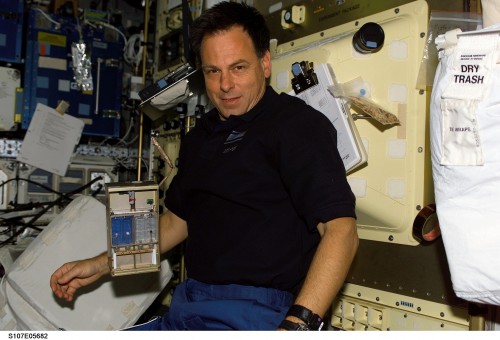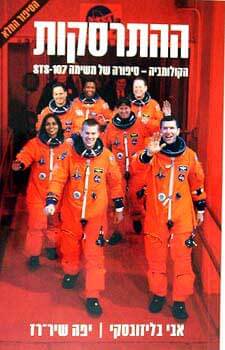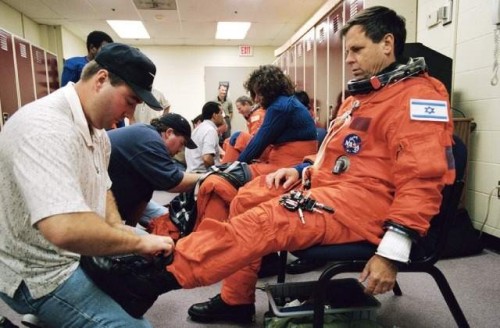If Col. In Ramon were alive, he would have celebrated his sixtieth birthday today, June 20. On the occasion of this event, we bring an excerpt from the chapter "Ilan", the third chapter in the book "The Crash" by Avi Blizovsky and Yefa Shir-Raz.

If Col. In Ramon were alive, he would have celebrated his sixtieth birthday today, June 20. On the occasion of this event, we bring an excerpt from the chapter "Ilan", the third chapter in the book "The Crash" by Avi Blizovsky and Yefa Shir-Raz. The chapter is based on interviews we conducted with some of his colleagues, as well as from the interview he gave to the editor of the science website and co-author of the book, Avi Belizovsk, in Houston about six months before the launch.
The book "The Crash - The Story of Mission 107" was published in 2003 by Kinneret Zamora-Beitan. As far as is known, it is not available in bookstores today.
Chapter 3: Ilan
The phone on the desk of Major General Ilan Ramon, head of the air force's munitions department, rang. "Do you want to be an astronaut?" asked the voice on the other end of the line. It was already quite late in the evening, at the end of a busy work day. Ramon, who was trying to finish his work as quickly as possible to finally get home, replied: "Stop messing with my brain. I have no time for jokes. I want to finish the day and get home."
But the voice on the other end was serious. "The commander of the air force asked us to locate an astronaut," he insisted. The caller was from the officers' department in the Air Force, the department that deals with personnel in the military. Ilan was silent for a moment, slowly digesting what was put upon him. This is not a prank, he realized.
"Give me some time to consult with my wife," he replied. The next morning, his answer was positive.
He heard the announcement about the final selection from Major General Dan Halutz, today the commander of the Air Force, who was his direct commander at the time. "Dan Halutz participated in the discussion about filling the position. When the decision was made that I would be the astronaut, he left the discussion, picked up the phone at my office and said to me: 'Ilan, you are an astronaut.' That's how I learned that I was chosen to be the first astronaut of the State of Israel," said Ilan.
Ilan Ramon was born on June 20, 1954 in Ramat Gan, to Eliezer and Tanya Wolferman. His mother was a Holocaust survivor, who survived the Auschwitz extermination camp. Later, he moved with his family to Be'er Sheva, where he spent most of his teenage years. He completed his high school studies at the third comprehensive high school and was an excellent student.
During the summer vacation of 1969, when the first man walked on the moon, 15-year-old Ilan was very excited. Neil Armstrong's famous words, "One small step for a man, one giant leap for mankind," were engraved deep in his heart. He never dreamed that 30 years later, he would get to meet and talk face to face with Armstrong and "Baz" Aldrin at the Houston Space Center. He could not have dreamed that in 34 years he would fly into space himself and become the first Israeli astronaut.
He described the moments of excitement that summer in one of the many letters he sent throughout his stay in the United States to his friends in the Air Force.
"In the large, air-conditioned control room in the center of the space in Houston, although the air conditioners worked well, the atmosphere was hot," Ilan wrote. "The date - July 20, 1969. The American dream, the will left behind by President John Fitzgerald Kennedy in the early sixties, was about to come true. For the first time a human was about to set foot on the moon's soil! Neil Armstrong and Buzz Aldrin are the two astronauts who landed on the lunar soil with the help of the Eagle lander, while in the "mother" vehicle orbiting in low orbit around the moon, Michael Collins is patiently (and jealously, I guess) waiting for them until they finish their mission and connect with him in order to return together to earth. I was that day in the middle of the big vacation, between the XNUMXth and XNUMXth grades at Mikif C High School in Be'er Sheva. I was among all those millions of people in the entire world, who anxiously and excitedly watched this historic event, and heard Neil Armstrong's famous sentence when he set foot on the moon."
30 years later, when asked in a NASA television interview whether he dreamed of becoming an astronaut, he replied: "When I was a teenager, no one in Israel dreamed of becoming an astronaut, for the simple reason that the issue was not on the Israelis' agenda. I am a former fighter pilot and I love to fly, but I never dreamed of being an astronaut. When I was chosen, I really jumped almost to space."

In 1972, Ilan enlisted in the Air Force, and in 1974 he was accepted to a combat pilot course. When he finished as the outstanding trainee of the course, none of his commanders and friends were surprised.
"The course was the first place where I recognized Ilan as a special person," said Major General Amos Yadlin, now the commander of the military colleges, who was one of Ilan's instructors in the pilot course, in an interview with Air Force Basetown in February 2003, after the disaster. "He was a humble, quiet and calm guy. Not that he didn't have ambitions, but they didn't see it in him. He was an exemplary trainee, professional, organized, works properly.
During the course, during one of the routine instrument flights, Ilan had to abandon the respite plane he was flying.
"Not everything went smoothly," Ilan recalled in an interview for the film 'Mission 107'. "I got kicked out of pilot's course," he said, laughing a rolling laugh. "It happened in the basic phase of the course. I went on an instrument flight. The instructor sat forward and I was behind him. I started the exercises. I did a loop once, then, when I started to do another exercise, I suddenly felt that the stick was not moving. 'Say, are you touching the stick?' I asked the guide. 'No,' he replied in bewilderment. 'I think the stick is stuck,' I said. The plane was in a diagonal loop. We tried to release the stick in every possible way. We even kicked him. But nothing helped. Ten minutes later we realized we had to abandon the plane. In the end I found myself outside without the helmet, which flew off as soon as I opened the canopy. As I jumped, my foot hit the tail of the fugue. But in the end I became an outstanding trainee."
"Such a traumatic abandonment is not an easy matter for a trainee, but Ilan returned to flying and they didn't see it on him," said General Yedlin.
Abandoning a break in the pilot course was not the only time Ilan had to abandon a plane. On January 20, 1982, he went on a training flight with his friends, during which they trained in dogfights against Phantom planes. He flew in formation with three other planes.
"Ilan V., his squadron mate, flew in the same structure," said Lt. Col. (Res.) D., Ramon's friend from the time of the pilot course in an interview with Air Force Basetown. "They headed in the direction of one of the 'enemy' planes, and when they returned, they found themselves on a collision course. In the seconds before the collision, Ilan V. tried to maneuver and get out of the dangerous lane, but they were unable to prevent it. In the end, they both left peacefully."
These two successful abandonments gave Ilan the name of one who gets out of any trouble safely. When he himself was asked to choose a nickname for himself as part of his training at NASA, as is customary among pilots in the American Air Force, the nickname he chose was CAT. When asked why, he replied that no matter what happens, the cat always lands on its feet. The fact that he was a skilled and talented pilot, who managed to get out almost unscathed from two plane crashes and dangerous operations, meant that in the moments after the disaster, even when the terrible fact became clear, that the Columbia was badly damaged and crashed, there were those who still hoped that Ilan, like a cat, would be able to be saved again.

Major General Amos Yadlin, who knew Ramon throughout his service in the Air Force, told about getting to know him during these years.
"The next time we met was in the 'Flying Tiger' squadron, the Skyhawks squadron. Ilan came as a young pilot. I was already a captain. We quickly realized that there was no point in keeping him in the Skyhawk squadron for a long time. He was an excellent pilot. We decided that he would stay with us for two periods and move to Mirage.
In 1976 we met again in the Eagle Squadron. I was a Sgt (deputy squadron commander) and Ilan was a young pilot who came from the Mirage conversion. During this period we had many, many hours together, both on joint flights and on trips. Since he lived in Be'er Sheva and I in Kibbutz Hatzerim, we would travel and return to the base together in the same Carmel Dukes. The base in Sinai where we served was still under construction. Except for a flight path and a few buildings, there was nothing there. The atmosphere was very pioneering, and we both felt very good together. I come from a pioneer kibbutz, and Ilan comes from a home of very special parents. We had to build a new squadron, and there was great creative joy in that. On the other hand, due to the fact that our squadron was not yet operational, we moved away from the front, which was then mainly in the north. We did not like this fact. We wanted to be in a place where people leap every day to MiGs. But it didn't affect Ilan. He is an exemplary soldier. When he performs a task, it is impossible to see its negative sides on him, only the positive ones. In his quiet spirit, he knew how to give the right comments. Normally, the youngsters in the squadron should be the opposition. But Ilan cannot be an opposition. Ilan was born a coalition, and it was just fun to have a guy like that in the squadron."
In 1981, when the Columbia shuttle was launched for the first time, Ilan was already an experienced pilot, flying F-16s. In the same year, Israeli Prime Minister Menachem Begin gave the order to attack the atomic reactor in Iraq. Ilan was the youngest pilot who participated in the attack. Brigadier General (Ret.) Israel (Rallik) Shapir, who was his "partner" for the mission, tells about the operation, and about the special relationship that developed between him and Ilan,
In an interview with Air Force Basetown: "In December 1980, squadron commander Zeev Raz called us, and informed us that the training we had carried out was intended to prepare us for the attack on the reactor in Iraq. Even then it was decided that the eight planes would be divided into pairs, and I would take Ilan in a pair. He was number 8 in the structure. I was number 7. From here, and for six months, we were a couple. Once every two or three weeks, we made a training flight and waited, like the whole team, for the day of command. Ilan and I were the only ones in the team who had no experience from the Yom Kippur War. From the analysis of the risks and from the estimates, it became clear to us that between one and two planes would fall in an attack. We immediately realized it was him and me, and joked about it a bit. We talked about the fact that we are the youngest, and we can be 'wasted'. I was already married and had a daughter, but Ilan was still single.
"Before the attack on Koor, we were of course more connected. We were all scared, but no one talked about it or showed it. There is a task and it needs to be done. In the last hours before leaving for the operation, we sat on the small details. We split into pairs and didn't say anything. Since we already knew each other well, we were close, so there was no need to talk much.
"When we left the attack, we dived to a low altitude at a speed of 600 knots. I remember that I was flying very low, at a height of 50 feet, but Ilan was below me. When we got home, we landed next to each other, got off the planes and hugged for a minute. All I wanted was just to touch someone, to know that I existed. It was a really special hug. The half year we were together as a 'couple' was something that stayed with us forever."
The attack on the reactor in Iraq was not the only important operation in which he participated. During his many years of service, he took part in sensitive missions and operations, many of which are still classified today.
In April 1983, at the age of 29, Ilan was released from the IDF and completed a bachelor's degree in electronics and computer engineering at Tel Aviv University. After graduating, he joined the development team of the Helia plane.
In 1988, after the project was stopped, he returned to the Air Force as the deputy commander of the "Bat" phantom squadron, a unit that performs high-altitude photography flights.
"In this unit, ten years before he dreamed of becoming the first Israeli astronaut, Ilan wore the orange astronaut outfit for the first time," says Lt. Col. Adir Harubi, Ilan's squadron mate, in an interview he gave us. "Due to the high altitude at which the unit's planes fly, reaching over 50 feet, the pilots must wear pressure suits, to allow the body to function. In fact, it is a standard suit worn by NASA astronauts, including the vests, the special glasses and the rotating helmet. He also experienced the experience of the first meeting with a 'space mini' through the high flights in the squadron. In such flights, there are some interesting phenomena. First, at an altitude of over 65 feet, when visibility is good, you can actually see the dome shape of the Earth from the air. Second, because of the very thinness of the air at these altitudes, visibility changes. When you look down you see a clear and beautiful earth and a big sky. When you look to the side and up, the blue color is lost and you see black, even though it is daylight outside. I went with Ilan on several such forays, which remind me of the experience of looking at the Earth from space. It was a beautiful sight. Who knows, maybe up there the decision in his heart to raise chicken was rewarded even more."
Two years later, he was given command of an F-16 squadron. In 1994, Col. Ilan Ramon was appointed head of the munitions department at the Air Force Headquarters, a position he held until he was chosen to be the first Israeli astronaut.
More of the topic in Hayadan:
